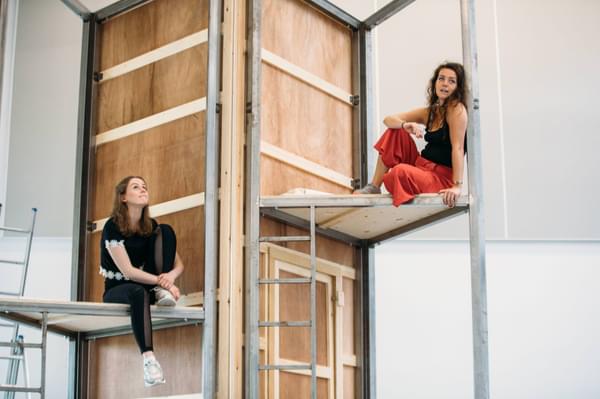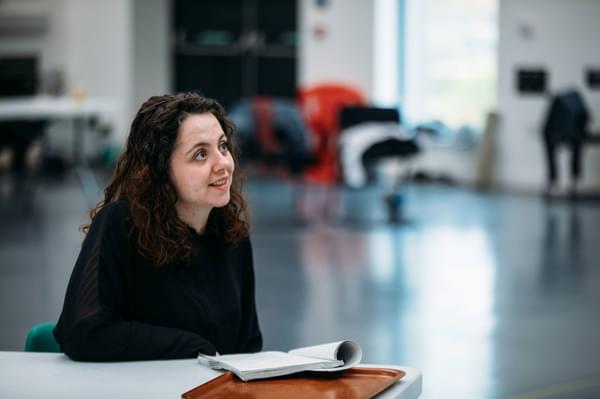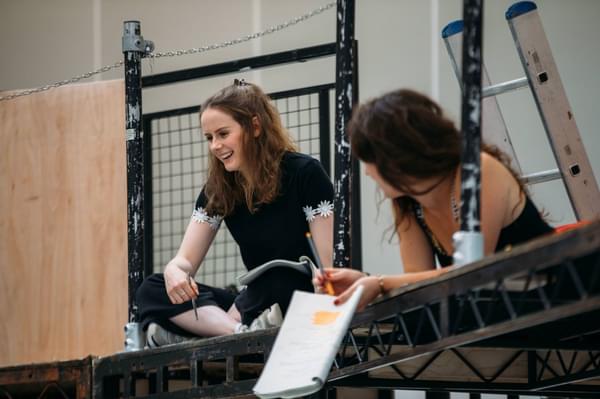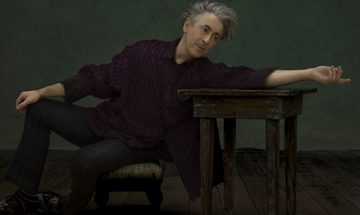News Story
There is a moment in rehearsals where the actors become wild things. They gnash their terrible teeth. Pound their feet. The Panopticon company is pushing itself as hard as it can — toward a point of no return. The actress playing the lead role of Anais (Anna Russell-Martin) shoves a circle of actors surrounding her — back out of her way. In a second she has cleared a space for herself. She drops to the floor in tears — fierce and sudden. Standing up to take a few steps away — she makes a sound that could be wolfish, it holds rage, strength, frustration. I know that sound. Debbie Hannan (Director) quietly tells me that this is a great thing, it can take actors weeks to get to this point. They have worked together before. Debbie trusts Anna in this moment. She is confident in this process, respectful that each actor has to come to the role truthfully. We are all pushing through something. The Panopticon has an ability to do that. Individually and collectively this is not the kind of journey that leaves you unchanged. The Panopticon is becoming a living, pulsating, world. It is under our finger nails. It trails home after us. It sits by the canal smoking each morning eyeing us all up as we go into work. I know how affecting this world can be. It is a story I never wanted to tell about a system I did not choose to be raised in.
Even now it still gets to me.
I wrote the novel of The Panopticon around ten years ago when I was living in Peckham. I wrote for twelve hours per day, seven days a week. I rarely left the world of The Panopticon until it was done. In the process of passing it over to this company I sit for days on end answering questions about the care system, there are so many nuances particular to my own very extreme upbringing. Many of these are things I never discuss. I push hard so they can too. I offer my soul so they will be better able to bring their own. The actors are unsure if they can own this material. I tell them they have to do so. Finding the root of what ties them to their character will help to humanise a demographic that is always discussed as a collective. Children from care are individuals. Just kids. Each brings their own unique self. I have got used to the process in stages. National Theatre of Scotland is made up of extraordinarily talented people. They are a joy to work with. Theatre itself is a medium that can make real, raw human experience stark as it can be. It also holds magic — even on an empty set. I love that. The challenges are many, not least emotionally. I met with Debbie Hannan many times before we got to the point of rehearsals. We spent a long evening having dinner at my flat. I talked a lot. Much of it was about music, counter culture, art, structuralism, poverty, abuse, neglect, youth offending, terminology, othering, policy, government, resilience, hope, tenacity, morality, surrealism, consciousness, fashion, literature. I told her about my own upbringing and why I have rarely spoken about it directly. We were able to meet each other as artists and women — people first, storytellers second. It was important. Once we had the measure of what The Panopticon meant to each other — a foundation of trust was ready to build on.

Performers in rehearsal for the Panopticon
Credit: Photography by Jassy Earl
Front to back, left to right: Kyle Gardiner, Anna Russell Martin, Lawrence H Mullings and Louise McMenemy (cast) in rehearsal for The Panopticon, 2019.
Credit: Photography by Jassy EarlDebbie Hannan is around the age I was when I was writing this novel. She is an impressive Director and human being. She has a formidable breadth of experience already behind her as a Director. I knew she would take the same risks I do as an artist. That she’d push as hard. It’s vital to the process. I aimed to support the script in a way that allows her vision to come through as well. I wanted to respect her process. Each draft was debated and settled into a solid shape.
In early discussions with Jackie Wylie (Artistic Director at National Theatre of Scotland) and Fiona Mackinnon (Associate Director of The Panopticon) we discussed how to bring Anais’ huge imagination into a visual world. I watched a play years ago that had animation throughout the set and it was stunning. They had seen it too. Working with a Video Designer (Lewis Den Hertog) and an animator (Cat Bruce) clicked as the right approach. We are building the world in layers. It’s so exciting to do.
In our first meeting with all the creatives we discussed how best to construct a floor, lighting, wardrobe, colour, props, music. There were conversations about the political importance of smoking effectively in The Panopticon: flying cats: how a dominatrix (Pat) imbibes lithium and why: the Experiment and where they come from — queries on the origins of existence: how best to inhabit violence and the appeal of vintage couture. There is no area we have not covered. I adore seeing these talented people bring The Panopticon alive. Our set designer Max Johns created the cleverest set for this iconic building. When we had that first meeting — he unpacked a tiny version of the set from a box. It was complete with artwork on the walls, characters to move around, it will be an imposing four-meters tall, made up of nine triangles, each with two levels. I was captivated. Right there — was a tiny world that had come out of my head, out of my childhood, out of a novel, into a play. As to the rest — well, we must keep the seams and inconsistencies to ourselves. When the first and last curtain falls it will be just the world of The Panopticon that is experienced — as it should be.
A version of this article can also be read in The Guardian.

Performers in rehearsal for the Panopticon
Credit: Photography by Jassy Earl
Performers in rehearsal for the Panopticon
Credit: Photography by Jassy EarlAbout The Author
Jenni’s debut novel, The Panopticon, received worldwide critical acclaim. It has been published in nine languages and is being adapted for film, for which she has written the screenplay.
In 2013, Jenni was the only Scottish writer to be on Granta’s Best of Young British Novelists list, a once-in-a-decade accolade. She is a prize-winning poet and has twice been nominated for The Pushcart Prize and has been on lists for The Sunday Times Short Story Award, The Dublin Impac Prize,The James Tait Black Prize, The Desmond Elliott Prize, The Encore Award, The BBC International Short Story Prize, and was named as one of the Waterstones 11 best worldwide debuts in 2012.
Jenni has written for The New York Times, The Independent and Marie Claire among others as well as collaborations with many charities and groups including Norfolk Blind Association, Scottish PEN, Amnesty, Lewisham Hospital neonatal unit, young offenders, women in prison in the UK and the US, and with women at risk. Jenni is a member of Liberty, an organisation which has fought for human rights since 1934.
Jenni has been Writer in Residence at The University of Edinburgh and her second novel, The Sunlight Pilgrims, was published in 2015 in the UK, US, France, Italy, and Czech. The Sunday Herald Culture Awards selected Jenni as the Scottish Author Of The Year in 2016. The Dead Queen of Bohemia (New & Collected poems) was published in 2016. Jenni’s most recent poetry collection There’s A Witch in the Word Machine was published in 2018.

